You are here
History of Tai Kazan in Turkestan.
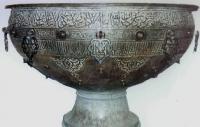
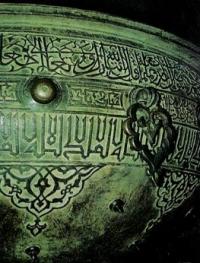
Guide to Turkestan.
“A large door, extremely finely carved, leads into the interior of the mosque. The first thing that strikes you is the extremely grand dome that covers the entire main building. The plafond of the dome made of stucco alabaster work would have done credit to the best European architect.
In the middle of the mosque stands a huge, fabulous size, bronze cauldron with relief inscriptions from the Koran and other decorations. The purpose of this bowl or cauldron - call it what you will - is to boil food for the poor; the cauldron is furnished on all sides with bunchuks and the banners of Azret-Sultan"
“Diary of 1866. Travel to Turkestan ". Alexander Konstantinovich Gaines (1833 - 1893).
Turkestan on map of Kazakhstan.
The variety and perfection of types and objects of arts and crafts concentrated in the temple of Khoja Ahmed Yasawi have long secured its reputation as a kind of museum of Muslim art. The objects in this museum are both external and internal decoration of the entire building, its architecture and individual artistic and decorative items that decorated the interior of the premises with their presence.
Among the latter, the most outstanding is undoubtedly the bronze kazan (tai-kazan), installed in the center of the central (and largest) room of the architectural complex, the jamaatkhan. Along with the building of the temple itself, this cauldron attracts the attention of anyone who steps under the dome of the Jamaatkhana.
The initial amazement at the grandeur and mystery of the design of the entire building is replaced by no less amazement and admiration caused by a huge bowl installed in the very epicenter of the architectural complex.
And if the grandiose portal of the temple and the interiors of most of the premises attract attention, among other things, also by its incompleteness, as if understatement, then the bronze cauldron, located in the architectural and planning focus of the entire complex, with its completeness, safety and informative richness, seems to leave no room for questions.
More than a century of scientific interest in this unique masterpiece of medieval decorative and bronze casting art is reflected in a rich bibliography including dozens of publications. There were no discrepancies in the understanding of the rich epigraphic decor of the cauldron, methods of constructing such a complex shape, methods of design and technology of its casting were studied, and the place of this masterpiece in the history of Oriental art was determined.
The Turkestan cauldron is unique, first of all, for its size. It is literally commensurate with the Timurov building itself, with the scale of its central hall covered with a dome “similar to the firmament”. Let us recall that the jamaatkhan hall, which is square in plan, has a side length of 18.2 meters, the top of the dome is raised 36 meters from the floor level.
The volume of the hall was increased due to two opposite deep (3.7 and 6.4 meters) niches with a height of 13.5 meters and lateral ones with a depth of 0.8 meters. Accordingly, the dimensions of the bronze cauldron standing in the center of the hall are striking. Its total height is 1.62 meters, the rim diameter is 2.42 meters, the lower diameter of the conical base-base is 1.08 meters, its height is 0.54 meters, the height of the boiler bowl is 1.08 meters.
It could hold up to 3000 liters of water, and the boiler's own weight was about two tons. Only the cauldron located now in the Herat Juma Mosque could compete with the Turkestan giant. But the diameter of the bowl of the Herat cauldron is much less than the Turkestan one - 174.5 cm, its height is about 1 meter.
The base was lost, but if we assume that the proportions of the items were close, then the total height of the Herat cauldron was about one and a half meters. It was cast, by the way, a little earlier than ours - in 1375 (776 AH) by the master Hasan ibn Ali Isfahani, as evidenced by the inscription on one of the two ornamental belts located in the upper part of the body of the Herat cauldron.
The surface of the Turkestan cauldron is also decorated with a rich intricate epigraphic ornament. It is placed in three horizontal belts, covering the upper half of the body. Two wide ornamental ribbons are, as it were, separated by a third, narrower one, passing along the largest diameter of the boiler and consisting of twenty cartouches alternating with the bases of openwork hinged handles and decorative knobs - "kubba".
The cartouches are filled in pairs with the Persian saying “be blessed” (repeated 10 times), eight cartouches are filled with islimi floral ornament, in two cartouches located next to each other, the author's “signature” of the master: master Sharaf ad-din Tabrizi ”.
The lower ribbon of the epigraphic decoration contains 22 times repeating Arabic inscription in Kufi handwriting on a smooth background - “Power belongs to Allah”. The most interesting in both decorative and informative terms is, of course, the upper ornamental belt. Against the background of a wavy stem with spirally rolled shoots in suls handwriting:
“Allah said, may he be blessed and may he be exalted: "Do you really consider the drinking of the pilgrim and the revitalization of the holy mosque a revelation?" And he said (the prophet), may there be peace over him: "He who builds a place for drinking on the path of Allah, may he be exalted, for him Allah will build a reservoir in paradise."
The emir ordered to build this place for drinking, the greatest ruler of the peoples of the world, chosen (distinguished) by the help of the merciful king, Amir Timur Gurgan, may Allah sanctify his almighty kingdom, for the tomb of the sheikh of Islam, the sultan of sheikhs in the world, sheikh Ahmed al-Yasevi, yes Allah will sanctify his great spirit. 20 shawval of the year 801.
As you can see, the inscription consists of three parts: - “Koranic”, which explains, as it seems to us, the presence of the cauldron at this place; "Author's", attributing the authorship of the idea to the emir Timur; and dating.
In connection with the placement of this date in the general system of decor, the researchers had one ambiguity - to date the order of Emir Timur according to it, or the day the cauldron itself was cast. It seems to us more preferable to attribute this date to the day of casting, i.e. by the time of the most complex and critical boiler manufacturing procedure.
But no matter how it was, it is necessary to recognize the date of Shawval 20, 801 AH, which corresponds to June 25, 1399 of our calendar, the “birthday” of the Turkestan tai-kazan, a masterpiece of the world decorative bronze casting art.
Among other things, here we have a case of a precisely dated historical inscription, unique for a Turkestan temple, which reliably connects the cauldron with the Emir Timur and the temple itself. The fact is that the bronze lamps in the temple also contain historical inscriptions with the name of the master Izz ad-din ibn Taj ad-din Isfahani, the date of 20 Ramazan 799 AH. (June 17, 1397) and an indication that these lamps were made at the direction of Emir Timur.
But, as A.A. Ivanov, in these inscriptions there is no mention of the fact that the lamps were made specially for the temple of Haji Ahmed Yasawi, and these inscriptions were made obviously somewhat later than the lamps themselves.
The building inscription at the end of the epigraphic frieze of the facades also contains the historical date - 800 AH (1397 -1398) and the name of the master - “Haji Hasan calligrapher from Shiraz”. But this date, according to experts, can only refer to the time when the decorative facing of the portals was finished, but not to the end of the work on the monument itself.
These works, as evidenced by the uncoated bulk of the main portal, many rooms devoid of decorative finishing, etc., were never completed. There is no reliable evidence of the time when the construction and facing work on the building, which was erected by the imperial command of Emir Timur, stopped.
It still remains unclear whether they were terminated due to the death of Timur in 1405, or in connection with the start of a new grandiose construction of the Bibi-khanym cathedral mosque in the capital Samarkand in 1399.
There are also many ambiguities with the date of the start of construction work in Turkestan. As you know, the main written source that sheds some light on this issue is the work of Sheriff ad-din Yezdi “Zafar name”.
It follows from this text that Emir Timur gave an order to rebuild the dilapidated complex of buildings over the grave of the “Sultan of the Sheikhs of the World” during his visit to the city of Yasy in 1397. However, M.E. Masson doubted the reliability of this date and recognized it as a chronological error (9, p14).
Subsequent historical and architectural studies in different ways presumably dated the period of construction and 1395 - 1399, and 1391 - 1399, and even 1389 - 1399. Thus, it turns out that of the entire complex of artistic and decorative attributes of the Turkestan temple, only the tai-kazan has an exact date of origin!
And on June 25, 1999, the 600th anniversary of this truly amazing creation of human hands falls. Local legend, as you know, connects the casting of the cauldron with the village of Karnak, located 23 km away. northwest of medieval Turkestan.
In its vicinity, local residents, according to M.E. Masson, have recently shown the remains of the "factory" where the boiler was cast. We have not yet managed to find this place, but it should be noted that the surroundings of the modern village Sidak.
In the village itself is located Tortkul of a small medieval settlement Saukum-ata (Shaukum-ata). Another medieval settlement, Shornaktobe, is mentioned in the “Archaeological Map” in the form of a tortkul 75 x 80 m, up to 3 m high, dated to the Ist - XIIth centuries.
The layers of the XIVth - XVth centuries not revealed during a superficial examination of these monuments, which would testify to the habitation of these settlements in the era of Timur, make us doubt such a localization of the historical city of Karnak.
More preferable in this sense is the settlement of Ishkan in the village of Atabay, which is 30 km away. northeast of the village. Cernak. To finally decide on this issue - where was the Turkestan cauldron actually cast? - more detailed archaeological research of these monuments will help.
Folk legends also preserved information about how the purpose of the boiler was understood. Some of them can be attributed to the mystical, which, apparently, were supported by local sheikhs. One of them is cited by M.E. Masson: the carcass of a sacrificial sheep placed in a huge cauldron miraculously filled it with meat if the sacrifice turned out to be godly.
Well, in fact, the cauldron was intended for water, this follows, as we have seen, from the inscription on the upper ornamental belt of the cauldron itself. The sweetened water from the cauldron was distributed to the faithful after Friday prayers, when a public memorial meal took place, during which the poor and pilgrims were treated to a specially prepared dish - "halim".
At first glance, it seems somewhat strange to use a vessel in the form of a cauldron as a container for a drink. The cauldron is more associated with cooking meat food. However, historical and cultural studies of a wide semantic spectrum of ideas associated with the cauldron in the traditional cultures of the peoples of Central Asia, primarily nomadic or semi-nomadic in the recent past, show that in ritual, i.e. sacralized, actions, cauldrons have been used since ancient times as containers for various intoxicating drinks.
The boilers could also be used for cooking, fermentation, and distillation of drinks (kumis, arak). In the Caucasus, Ossetians brewed beer in bronze cauldrons. Naturally, in the Islamized interpretation of this ancient nomadic custom, sweet water became the drink of communion from one vessel.
In general, the semantics of the cauldron in the culture of ancient and medieval nomadic peoples is unusually rich. In the epos and myths, legends and tales of the vast Eurasian region, there are close semantic connections between the cauldron and the bowl, the goblet, and more broadly, with the “sacred vessel”.
This topic in connection with the Turkestan boiler is extremely exciting and requires a separate development. Its disclosure reveals another powerful layer of ancient Turkic-Iranian mythological concepts underlying the cult of the Turkestan shrine.
The closeness of the shape of the Turkestan cauldron and the nomadic cauldrons of the “Scythian type” that existed among the medieval nomads is obvious. Given the extraordinary conservatism of popular consciousness, it can be assumed that the ideas and associations associated with the cauldron among many nomadic peoples in the past are very close and traditional.
If we recall that Emir Timur remained, like his Turkic-Mongolian ancestors, the heir of the steppe in their origins of culture, it becomes more understandable why a vessel “for drinking” appeared in the center of the temple above the grave of a Muslim missionary in the form of a bronze cauldron, traditional for nomadic culture.
Huge, ornate cauldrons were a fairly common feature. Sufi khanaka, whose communities retained echoes of ancient pre-Islamic cults. In addition to the aforementioned "Herat" cauldron, it is known that in the city of Konya in the khanaka ("tekke", "turba") of Jelalladdin Rumi there was a huge bronze cauldron. In the khanaka over the grave of another most popular Sufi saint in Turkey, Khoja Bektash (near the town of Kirshehir), there is a bronze cauldron, amazing in its size - “for 24 bulls”.
By the way, it was presented to the khanaka by Emir Timur. And the widespread folk legends about Khoja Bektash call him the grandson of Khoja Ahmed Yasavi, experts consider the Asia Minor Sufi Bektashi order the spiritual successor of the Yasavya order founded by Khoja Ahmed.
Another interesting historical plot is connected with the question-whether originally, i.e. right after casting, did the boiler take place in the center of the jamaatkhan hall? The fact is that recent archaeological research in the center of the jamaatkhan discovered a deep well here.
It turned out to be filled with construction waste, in which, among the fragments of burnt square bricks, we came across fragments of ganch plaster with traces of blue painting, fragments of glazed tiles from the lining of the lower panel of the hall, etc.
Based on this, it could be concluded that the well ceased to function and was filled with garbage much later construction of the Timurovsky building. Most likely, during one of the major repairs, when it was necessary to remove the partially collapsing facing of the panels, to knock down the lagging painted plaster.
Folk legends, the information of which acquires a person that it was after these repair and construction works (under Abdullakhan, according to legend, the arch of the main portal was completed) the bronze cauldron of the master Abd al-Aziz took place in the center of the main hall of the building.
But where did he stand for two whole centuries? Was he even in the building of the Turkestan temple? Even this can be doubted ... In the spring of 1509, the city of Yasy and the tomb of Khoja Ahmed was visited by Fazlallah ibn Ruzbihan Isfahani, a learned Persian who first came to Central Asia and “with greedy eyes watched the life of unfamiliar peoples, their customs, norms of behavior of various social groups and court etiquette the founder of the feudal Uzbek dynasty of the Shaybanids, whose companion and advisor he happened to be for several years."
In his travel notes, he devoted many lines of admiration for the splendor of the Timurov building. With the lush ornateness characteristic of that time, he mentioned in the description of the Turkestan temple many realities that struck him - high domes and arches, suffs, ayvans and a vast courtyard life thirsty in the valley of seeking”.
But ... not a word is mentioned the magnificent bronze cauldron (!), Which most of all deserves the attention of the author's generous epithets. But a deep well is mentioned, “the beginning of the Salsabil spring, which gives a drink of relaxation to those wandering in the valley of fatigue to taste.”
If we take into account the opinion of M.E. Masson that the well in the current “Kudukhan” was dug at the beginning of the 19th century, then we will have to admit that that the "Bukhara guest", being for several days at the most holy tomb, drank water from this very well, located in the center of the jamaatkhan.
But where was the huge bronze cauldron if the inquisitive "learned Persian" did not see it in the temple?
Geographic coordinates of mausoleum of Khoja Ahmed Yasawi: N43 ° 17'51.69 "E68 ° 16'15.06"
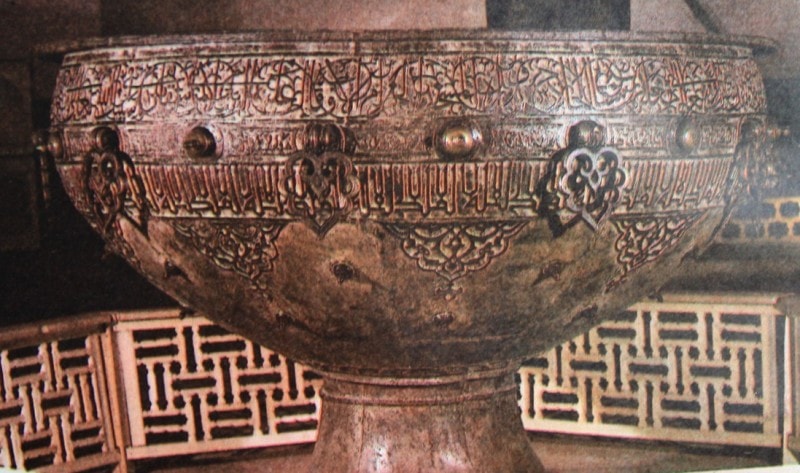
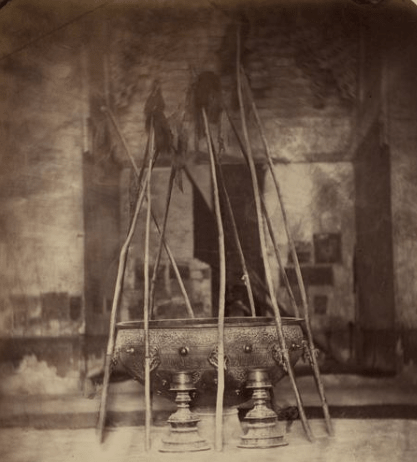
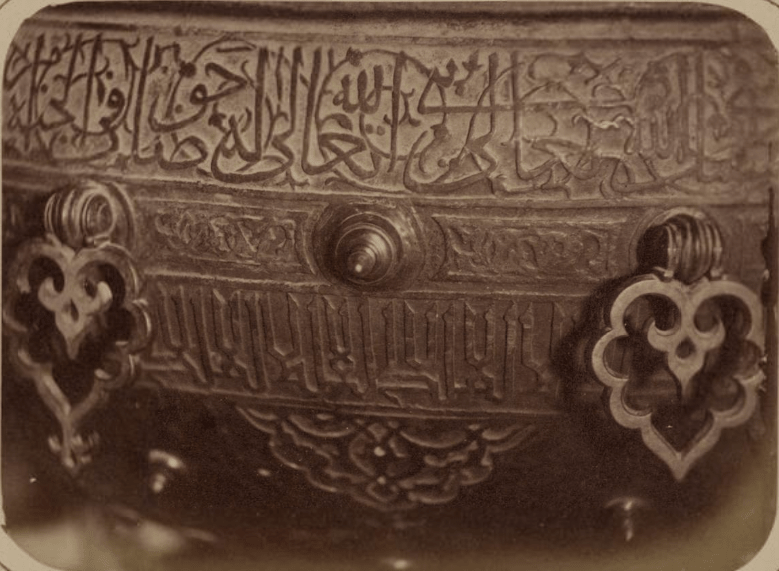
Authority:
Institute of Archeology named after A.Kh. Margulan, National Academy of Sciences of the Republic of Kazakhstan, Ph.D. Smagulov E.A.
http://www.heritagenet.unesco.kz
Literature:
Ageeva E.I., Patsevich G.I. From the history of settlements and cities of South Kazakhstan. // Proceedings of the IIAE Academy of Sciences of the Kazakh SSR, v.5, Alma-Ata, 1958.
Archaeological map of Kazakhstan. Registry. Alma-Ata. 1961.
Baypakov K.M. Medieval urban culture of South Kazakhstan and Semirechye. Alma-Ata, 1986.
Bekchurin M.-S. Description of the Azret Mosque. Notes of the State Councilor Bekchurin. // Military collection, 1866, №8.
Bulatov M.S. Masterpiece by master Abdl Aziz. // Well. Soviet archeology, No. 2., 1969.
Ermolenko L.N. On ritual vessels for sacred drinks among ancient nomads (vessels on a pallet). // in collection: Issues of archeology of Kazakhstan. issue 2, Almaty-Moscow, 1998
Ivanov A.A. About bronze items of the late XIV century. from the mausoleum of Khoja Ahmed Yasevi. // on Sat. : Central Asia and its Neighbors in Antiquity and the Middle Ages. M., 1981
Mankovskaya L.Yu. Mausoleum of Ulugbek's daughter Rabiya Sultan Begim. // Social sciences in Uzbekistan, no. 3, 1969.
Masson M.E. About the construction of the mausoleum of Khoja Ahmed in the city of Turkestan. // in collection: Riddles of ancient Turkestan. Almaty, 1998.
Masson M.E. Mausoleum of Khoja Ahmed Yasawi. Tashkent, 1931.
Pugachenkova G.A. Architecture of Central Asia. 15th century. Tashkent, 1976.
Tuyakbaeva B.T. Epigraphic decor of the architectural complex of Ahmed Yasawi. Alma-Ata. 1989.
Tuyakbaeva B.T., Proskurin A.N. To the history of the construction of the khanaka of Khoja Akhmed Yasevi. // in collection: Riddles of Ancient Turkestan. Almaty, 1998.
Fazlallah ibn Ruzbihan Isfahani. Mikhman name-yi Bukhara (Notes of a Bukhara guest). Edited by A.K. Arends. M., 1976.







